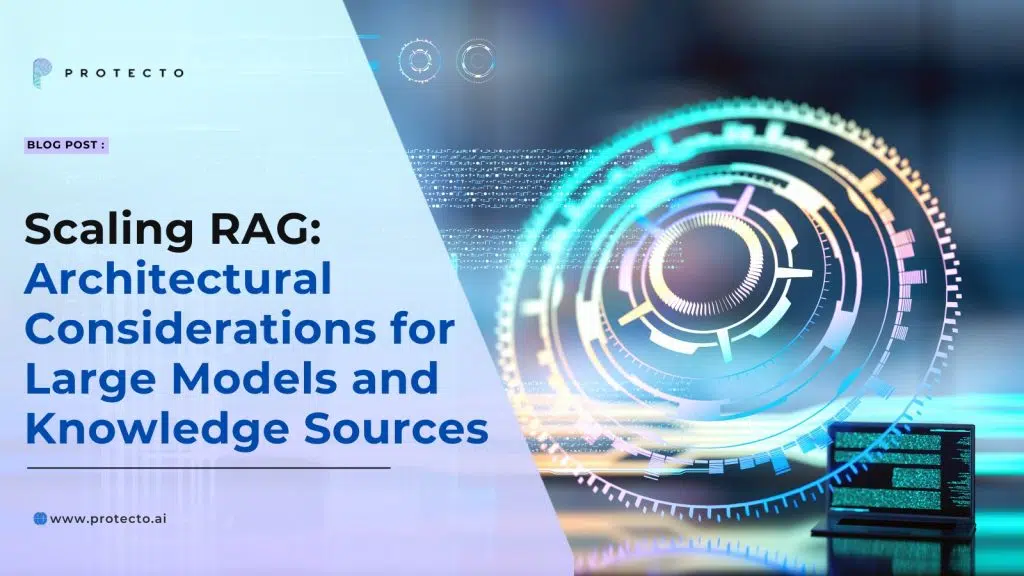Retrieval-Augmented Generation (RAG) is a cutting-edge strategy that combines the strengths of retrieval-based and generation-based models. In RAG, the model retrieves relevant documents or information from a vast knowledge base to enhance its response generation capabilities.
This hybrid method leverages the power of large language models, like BERT or GPT, to generate coherent and contextually appropriate responses while grounding these responses in concrete, retrieved data. This process significantly improves the accuracy and reliability of the generated content, making it particularly useful in applications requiring detailed and factual information.
Importance of Scaling RAG for Large Models
As language models persist in growing in size and complexity, scaling RAG becomes crucial to fully leveraging their potential. Large models can process and generate vast amounts of data, but without efficient retrieval mechanisms, their performance can be hindered by limitations in accessing relevant knowledge.
Scaling RAG involves optimizing the retrieval and generation components to handle larger datasets and more complex queries. This ensures that the models maintain high performance and reliability even when deployed in increasingly demanding environments. Effective scaling of RAG can lead to significant advancements in various fields, including customer support, healthcare, and financial services, by providing precise, context-aware, and actionable insights.
Architectural Components of RAG

Base Model Architecture
Transformer Models (e.g., BERT, GPT)
Transformer models, such as BERT and GPT, form the foundation of RAG systems. These models leverage self-attention mechanisms to process and generate human-like text, enabling them to understand and produce contextually relevant responses. BERT (Bidirectional Encoder Representations from Transformers) excels in understanding the context from both directions, making it highly effective for tasks that require deep comprehension of the text. On the other hand, GPT (Generative Pre-trained Transformer) is designed to generate coherent and contextually appropriate text, making it ideal for generative tasks in RAG systems.
Integration with Retrieval Mechanisms
Integrating retrieval mechanisms with transformer models enhances their capability by allowing them to access external knowledge sources. This integration involves augmenting the generative model with a retrieval component that can fetch relevant information from large datasets or knowledge bases. The retrieved data is fed into the transformer model, enriching its responses with up-to-date and accurate information. This synergy between retrieval and generation is crucial for improving the quality and reliability of responses in RAG systems.
Knowledge Sources
Structured vs. Unstructured Data
Knowledge sources in RAG systems can be categorized into structured and unstructured data. Structured data, such as databases and spreadsheets, is highly organized and easily searchable. It includes information that can be systematically processed, like customer records or financial data. Unstructured data, like text documents, images, and videos, requires a predefined structure and advanced processing techniques to extract useful information. RAG systems must be designed to efficiently handle both data types to provide comprehensive and accurate responses.
Databases and Knowledge Bases
Databases and knowledge bases are essential components of RAG systems, serving as structured and unstructured data repositories. Databases store structured data, enabling quick retrieval and manipulation through query languages like SQL. Often encompassing a more comprehensive range of unstructured data, knowledge bases support more complex queries and inferencing capabilities. They leverage ontologies and semantic technologies to provide contextually rich information, crucial for enhancing the quality of responses generated by RAG systems.
Retrieval Mechanisms
Dense vs. Sparse Retrieval
Dense and sparse retrieval are two primary approaches RAG systems use to fetch relevant information. Dense retrieval leverages embeddings and neural networks to find semantically similar data points, even if they don’t share exact terms with the query. This method is particularly effective for understanding context and nuances in queries. Sparse retrieval, on the other hand, relies on traditional term-matching techniques, such as TF-IDF or BM25, to retrieve documents containing specific keywords. Combining both approaches can enhance the retrieval performance by balancing precision and recall.
Indexing Techniques
Effective indexing techniques are crucial for optimizing retrieval processes in RAG systems. Indexing involves organizing and storing data to allow for efficient searching and retrieval. Techniques like inverted indexing, used in sparse retrieval, create a mapping from terms to their occurrences in documents, enabling quick lookups. In dense retrieval, vector-based indexing, such as those using Approximate Nearest Neighbor (ANN) algorithms, organizes data points in high-dimensional spaces to facilitate fast and accurate similarity searches. Implementing robust indexing techniques is essential for ensuring the scalability and efficiency of RAG systems.
Challenges in Scaling RAG

Model Complexity
Computational Requirements
Scaling RAG involves significant computational demands due to the sophistication of the underlying models. Large models, such as those based on transformer architectures like GPT-3 or BERT, require extensive computational resources for training and inference. As the model size increases, so do the requirements for GPU or TPU resources, impacting both cost and energy consumption. Efficiently managing these computational needs is critical to ensure the feasibility and sustainability of scaling efforts.
Memory Constraints
Memory limitations pose another challenge in scaling RAG. Large models and extensive knowledge bases demand substantial memory capacity, often exceeding the capabilities of standard hardware configurations. Techniques such as model partitioning, gradient checkpointing, and memory optimization are essential to handle these constraints. Balancing memory usage without compromising model performance is crucial in scaling RAG systems.
Data Management
Handling Large Knowledge Sources
Effectively managing vast knowledge sources is a crucial aspect of scaling RAG. These sources can include structured data like databases and unstructured data such as text corpora. Ensuring the integrity, accuracy, and relevance of this data is vital. Efficient data handling mechanisms, including data preprocessing, indexing, and storage solutions, must be implemented to maintain the performance and reliability of the system.
Real-Time Data Retrieval
Real-time data retrieval is essential for the responsive performance of RAG systems. As the knowledge base grows, the complexity of retrieving relevant information in real time increases. Advanced indexing techniques, optimized query processing, and caching mechanisms are required to meet the demands of real-time data access. Ensuring low-latency retrieval while scaling the knowledge base is a significant challenge.
Latency and Throughput
Reducing Response Time
Minimizing response time is critical for user satisfaction and system efficiency. As RAG systems scale, the increased data volume and model complexity can lead to higher latency. Techniques such as model distillation, ANN search, and hardware acceleration are employed to reduce response times. Achieving low latency without sacrificing the accuracy and relevance of the generated responses is a delicate balance.
Enhancing System Efficiency
System efficiency encompasses both computational and operational aspects. As RAG systems scale, maintaining efficiency involves optimizing resource usage, reducing redundancy, and streamlining processes. Implementing distributed computing frameworks, leveraging cloud-based resources, and employing efficient data processing pipelines are strategies to enhance overall system efficiency. Ensuring the system scales seamlessly while maintaining high performance and reliability is a core challenge in scaling RAG.
Strategies for Efficient Scaling

Optimizing Model Architecture
Model Pruning and Compression
Model pruning and compression are critical techniques for optimizing the architecture of large models. By selectively removing non-essential parts of the model, pruning reduces the size and complexity, leading to faster computations and lower memory usage. Compression techniques, such as quantization and knowledge distillation, further enhance efficiency by reducing the precision of model parameters and transferring knowledge from larger models to smaller, more efficient ones. These methods help maintain performance while making the model more manageable and scalable.
Layer-wise Training Techniques
Layer-wise training techniques involve training different neural network layers sequentially rather than simultaneously. This approach allows for better fine-tuning of each layer, ensuring the model converges more efficiently. Techniques such as layer-wise learning rate adjustment and freezing specific layers during training can significantly improve training speed and model performance, making it easier to scale the model for larger datasets and more complex tasks.
Enhancing Retrieval Efficiency
Advanced Indexing Methods
Advanced indexing methods are crucial for improving the retrieval efficiency of large knowledge sources. Techniques like inverted indexing, locality-sensitive hashing, and vector-based indexing enable faster and more accurate retrieval of relevant information. These methods ensure the system can handle large volumes of data while maintaining quick response times, which is essential for real-time applications.
Parallel and Distributed Retrieval Systems
Parallel and distributed retrieval systems leverage the power of multiple processors and distributed computing environments to handle large-scale data retrieval tasks. By distributing the workload across several nodes, these systems can significantly reduce latency and improve throughput. Implementing parallel processing and distributed retrieval frameworks like Apache Hadoop or Apache Spark can enhance the overall efficiency and scalability of the RAG system.
Data Optimization Techniques
Data Preprocessing and Cleaning
Effective data preprocessing and cleaning are foundational for optimizing data quality and retrieval performance. This involves removing duplicates, correcting errors, and standardizing data formats to ensure consistency and reliability. Clean and well-structured data reduces noise and improves the model’s accuracy, leading to better performance and more efficient scaling.
Utilizing Caching Mechanisms
Caching mechanisms are vital for reducing the time required to access frequently used data. By storing the results of common queries and computations, caching minimizes the need to retrieve and process the same data repeatedly. Implementing cache systems like Redis or Memcached can enormously enrich the speed and efficiency of the RAG system, enabling it to scale effectively while maintaining high performance.
Final Thoughts
The future of scaling RAG systems lies in adopting emerging technologies such as quantum computing and neuromorphic computing, which promise to revolutionize processing power and efficiency. Evolving standards and best practices, driven by industry and community efforts, will ensure RAG systems are scalable, secure, and effective.
Utilizing services like Protecto can significantly enhance the security and efficiency of RAG systems. Protecto offers advanced data protection, privacy compliance, and optimization tools, ensuring that large models and extensive knowledge sources are managed and scaled effectively.




